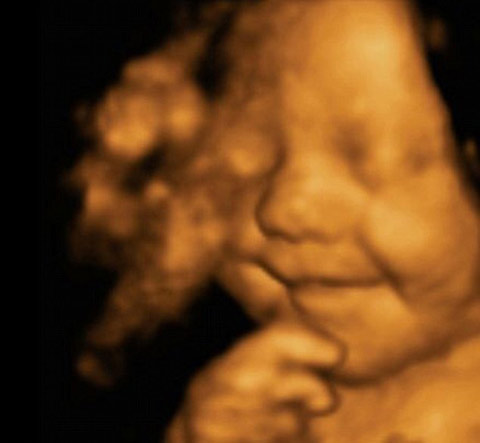|
Grinning from ear to ear, this picture shows little Leo Hargreaves was rather happy with his world – even before he was born.
And his parents believe their son may be the happiest baby in Britain as he hasn’t stopped smiling since.
The remarkable image was taken from an ultrasound scan at 31 weeks.
His mother Amy Cregg, 24, said: 'My partner Leighton and I were absolutely shocked - even the people who did my scan were amazed.
'But that was just the beginning. After he was born, he was always smiling - even in his sleep.'
Now nearly five months old, Leo has been dubbed the happiest baby in Britain.
The image is a 4D scan - increasingly popular with expectant parents to get a glimpse of how their child will look.
Rather then the grainy ‘flat’ images produced by the 2D scanners usually used by the NHS, a 4D machine stitches together pictures taken from a variety of angles to create clear three-dimensional images.
These are then recorded on video – the fourth dimension.
Ms Clegg, from Accrington, Lancashire, said she has already had modelling companies approach her trying to capture Leo’s smile.
The rehabilitation support worker said: 'I’ve been walking in the park and had people come up to me and say "What a gorgeous baby".
'I’d be interested in him doing modelling but only when he’s older.'
A spokesman for the company that performed the scan, at Babybond Ultrasound Direct in Burnley, said: 'Our sonographer who scanned Amy and her gorgeous baby was overwhelmed at her smiley baby throughout the entire scan.'
4D scans are a highly developed form of traditional ultrasound where very high frequency sound waves are used to produce images of what is inside the body.
As with older forms of ultra-sound, sound waves a emitted from a transducer, or probe, which is placed on the mother's abdomen and then moved to 'look at' areas in the uterus.
These sound waves bounce back off the foetus, helping to create a 'picture' of the child on a screen.
4D scans use the same frequency of sound waves as in a normal ultrasound.
But the sound waves are directed from many more angles, producing a 'real-time' video of the foetus as it moves and allowing scientists to say the images are in four dimensions.
|
照片上這位名叫里奧?哈格里夫斯(Leo Hargreaves)的小寶貝還未出生就已經(jīng)咧著嘴笑個(gè)不停�,一臉幸福的樣子�。
里奧的父母相信他們的兒子是全英國(guó)最快樂(lè)的寶寶�,因?yàn)樗男θ輳奈聪А?/p>
這張與眾不同的照片來(lái)自于超聲波掃描��,當(dāng)時(shí)里奧才31周大�。
里奧的母親艾美?克萊格(Amy Cregg)今年24歲���,她說(shuō):“我和我的愛(ài)人萊頓(Leighton)大感驚奇�����,甚至那些給我做掃描的人們也驚嘆不已�����。不過(guò)那只是個(gè)開(kāi)端����。他出生之后也一直在笑,甚至在睡夢(mèng)中�。”
現(xiàn)在的里奧快有五個(gè)月大了�����,他已經(jīng)被冠上全英國(guó)最快樂(lè)小寶寶的稱(chēng)號(hào)�。
圖像由4D掃描采集。這項(xiàng)技術(shù)越來(lái)越受準(zhǔn)爸爸準(zhǔn)媽媽的歡迎�����,他們迫不及待地想要一窺自家孩子的模樣����。
英國(guó)國(guó)民保健服務(wù)(NHS)通常使用2D掃描,由此拍出的圖像是平面點(diǎn)狀物�����,而4D掃描則將多角度拍攝而成的圖片拼接在一起組成清晰的三維圖像。
這第四個(gè)維度就是寶寶在母親肚子里的一舉一動(dòng)被記錄成像��。
母親克萊格女士來(lái)自蘭開(kāi)夏郡(Lancashire)�����,是一位康復(fù)治療師�。她說(shuō)她已經(jīng)接到幾家模特公司的邀請(qǐng)��,希望能拍攝寶寶的笑容����。
“我在公園里散步就會(huì)有人走過(guò)來(lái)說(shuō)‘多可愛(ài)的寶寶啊’?���!?/p>
“我對(duì)他做模特拍片的事很有興趣,不過(guò)只有等他再大點(diǎn)兒才行�。”
位于伯恩利一家名為Babybond的超聲波醫(yī)療公司為里奧拍攝了4D掃描圖像����。該公司的新聞發(fā)言人稱(chēng)當(dāng)時(shí)給母子兩進(jìn)行超聲波檢查的醫(yī)生在看見(jiàn)完整的圖像后也被寶寶的笑容征服了。
傳統(tǒng)超聲波技術(shù)利用超頻聲波成像來(lái)顯示人體內(nèi)的情況,而4D掃描則在此基礎(chǔ)之上進(jìn)一步發(fā)展��,技術(shù)更為成熟��。
不過(guò)和舊有超聲波傳遞方式一樣���,聲波通過(guò)母親小腹上的傳感器或者探測(cè)器進(jìn)入人體�����,同時(shí)借助它們的移動(dòng)來(lái)“瞧”子宮的內(nèi)部情況����。
這些聲波在遇到胎兒時(shí)會(huì)被彈回��,胎兒的“照片”也就能顯示在屏幕上了���。
4D掃描的聲波頻率和普通超聲波技術(shù)使用的相同�����。
只是4D的聲波能多角度幫助紀(jì)錄胎兒在母體內(nèi)的活動(dòng)并形成一部“實(shí)時(shí)”動(dòng)畫(huà)���?��?茖W(xué)家們也有理由稱(chēng)其為四維成像。
(譯者:orchismessi 編輯:丹妮)
掃一掃���,關(guān)注微博微信
 
|

